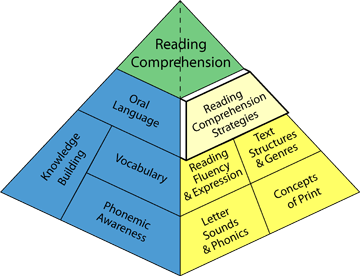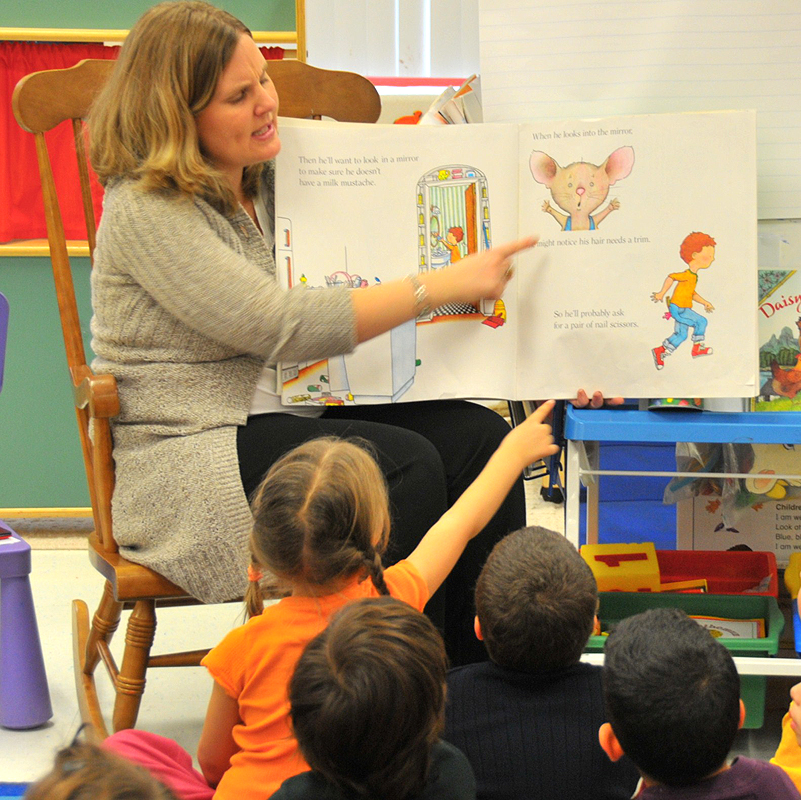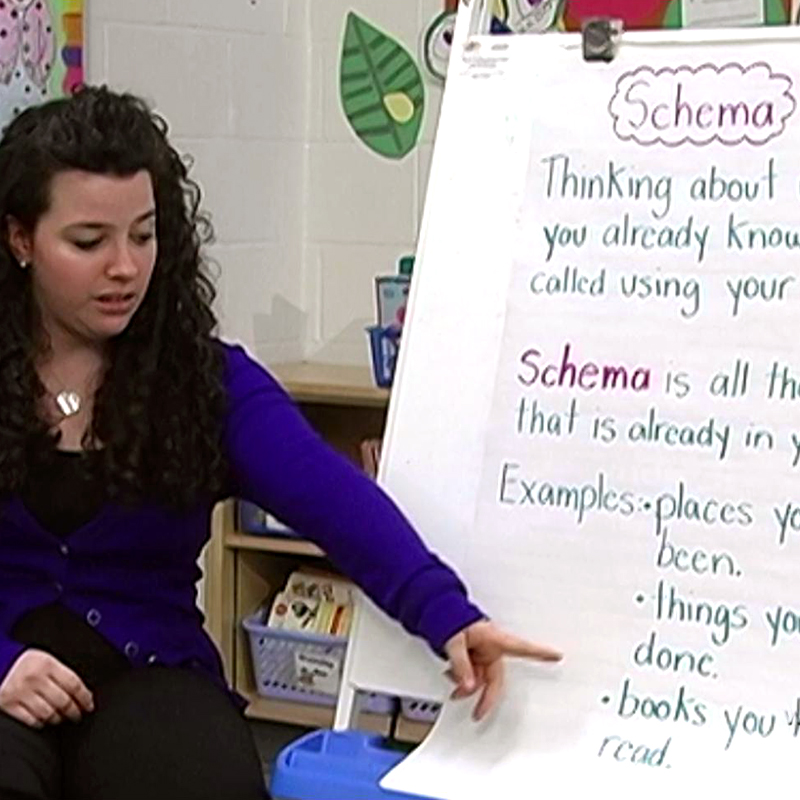Reading Comprehension Strategies
What the experts say about reading comprehension strategies:
Comprehension strategies are not ends in themselves; they are means of helping your students understand what they are reading. ~ National Reading Panel
Great books are central to teaching comprehension. ~ Stephanie Harvey
Reading is not just about what is going on in the book - it's about what's going on in your head! ~ Adrienne Gear
Read more about reading comprehension strategies!
Test 1
Test 2
OVERVIEW of reading comprehension strategies
Good readers tend to use a range of strategies while reading such as making predictions before reading, making connections to personal experiences and knowledge, and engaging in self-monitoring (on-going checks of text comprehension). Teachers can model, teach, and promote the use of these and other effective comprehension strategies to help their students become even more proficient readers.
TEACHING reading comprehension strategies
Highlight the need for students to be actively engaged in the reading process. Teachers can explain key strategies and model the types of actions students can take before, during, and after reading. Students will likely need ongoing feedback to facilitate their proficiency at using comprehension strategies. Explicit instruction in the key elements of a strategy helps students at all grade levels.
ASSESSING reading comprehension strategies
Assessment is an ongoing process helping students understand their strengths and next steps in order to become successful readers. Monitor each student’s progress by making regular observations during conferences and guided instruction. Ask, can they retell the main events of a story? Are their predictions appropriate? Are they able to identify and accurately describe events from the text?
Featured Videos
Let’s Make Predictions:
VIDEO
Mind Pictures:
VIDEO
Before, During and After Questions:
VIDEO
All Reading Comprehension Strategies Recipes
Read to Someone: A Component Of The Daily Five
Summary Map: Scaffolding Summary Writing
Before, During and After Questions: Promoting Reading Comprehension and Critical Thinking
Let's Make Predictions: Building Reading Comprehension
The Daily Five: Fostering Literacy Independence in Pre-Kindergarten
Running Records: Assessing and Improving Students' Reading Fluency and Comprehension
Five Senses Story Reading: Building Reading Comprehension
Sentence Starters for Text-to-Self Connections: Building Reading Comprehension Strategies
Interactive Story Retelling: Encouraging Retelling with Picture Supports
What Are They Thinking?: Using the Subtext Strategy to Build Comprehension
Real-Life Examples, Fact, and Fiction: Building Knowledge at the Beginning of a Content Area Unit
Mind Pictures: Promoting Comprehension through Visualization
Question Chart: Improving Reading Comprehension through Questioning
In Your Own Words: Learning How to Paraphrase
Who Wears These Shoes?: Making Inferences to Promote Comprehension
Reader's Notebook: Motivating Students to Read, Write, and Reflect
Pal Reading: Developing Fluency and Comprehension with Paired Reading
Pictorial K-W-L: Graphic Organizer for Early Literacy
To the Next Power: Using Power Notes to Organize Information
The True Story: Interviewing Book Characters to Build Comprehension
Getting to Know My Character: Using Character Maps to Build Comprehension
Categorizing Prior Knowledge: Aiding Comprehension of a New Content Area Text
Sticky Notes: Determining Importance in Non-Fiction Texts
Concept Muraling: Organizing Knowledge Visually to Improve Comprehension
Tableau Summaries: Using Action Strategies to Deepen Comprehension
Class Photo Library: Motivating Descriptive Writing
Reader's Notebook: Promoting the Use of Comprehension Strategies through Letter Writing (Virtual Tour)
Who Wears These Shoes?: Building Comprehension by Making Inferences (Virtual Tour)
The Daily Five: Fostering Literacy Independence in Third and Fourth Grade (Virtual Tour)
CAFÉ: Engaging Third and Fourth Grade Students in Assessment and Instruction (Virtual Tour)
Guided Reading: Promoting Fluency and Comprehension in Third and Fourth Grade (Virtual Tour)
Book Cover Design: Writing a Summary (Virtual Tour)
Gathering Place: Promoting Independent Reading and Comprehension Strategies (Virtual Tour)
Make a Judgment: Using Four Corners to Further Comprehension (Virtual Tour)
The Daily Five: Fostering Literacy Independence in Second Grade (Virtual Tour)
A Tool for Reading: Using Whiteboards during Guided Reading (Virtual Tour)
Launch with a Read-Aloud: Initiating an Integrated Literacy Unit with an Engaging Text (Virtual Tour)
Literature Circles: Fostering Critical Thinking and Oral Communication (Virtual Tour)
Author's Perspective: Comprehending Point of View (Virtual Tour)
Think Alouds: Modeling Ways to Think About Text (Virtual Tour)
The Daily Five: Fostering Literacy Independence in Second Grade (Virtual Tour)
CAFÉ: Engaging Second Grade Students in Assessment and Instruction (Virtual Tour)
Reading Power: Building Comprehension Skills (Virtual Tour)
What Do You Wonder?: Building Comprehension through Questions (Virtual Tour)
Read to Self in Second Grade: A Component of the Daily Five (Virtual Tour)
Read To Someone in Second Grade: A Component Of The Daily Five (Virtual Tour)
Tic Tac Toe Homework: Applying Reading and Writing Skills (Virtual Tour)
Open-Ended Questions: Organizing Ideas Using an Anchor Chart (Virtual Tour)
Let's Connect: Using Anchor Charts to Make Connections (Virtual Tour)
What's the Big Idea?: Understanding the Author's Message (Virtual Tour)
Guided and Independent Reading: Running Records (Virtual Tour)
Paired Reading: Building Reading Fluency
Semantic Web: Activating Prior Knowledge to Promote Understanding
Miss Nelson Is Missing!: Read-Aloud Activities to Build Vocabulary and Comprehension
How to Use CAFÉ : Involving Students in Building Essential Reading Skills
Tricky Words Strategies: Promoting the Flexible Use of Word-Solving Strategies
Paint That Event!: Supporting Descriptive Writing
Listening to Reading: A Component Of The Daily Five
Read to Self: A Component Of The Daily Five
Four Square Retelling: A Graphic Organizer for Retelling Narratives
Go Chart: Understanding Story Elements in First Grade (Virtual Tour)
Literacy Centers: Developing Skills in Reading and Writing (Virtual Tour)
Reading Toolkit: Fostering Independent Reading in First and Second Grade (Virtual Tour)
Visualize It!: Improving Comprehension through Visualizing Comparisons (Virtual Tour)
Book Bins: Organizing Student Materials (Virtual Tour)
Reading and Writing Hat Stories: Say Something about Comprehension Strategies
Retell the Text: Teaching Tips for Summarizing (Virtual Tour)
Sing Those Strategies!: Engaging Students in Reading Comprehension Strategies
Puppets and Props: Building Oral Language by Retelling Familiar Stories (Virtual Tour)
Guided and Independent Reading: Personal Boxes (Virtual Tour)
Guided and Independent Reading: Browsing Bins (Virtual Tour)
Guided Reading: Promoting Fluency and Comprehension in First Grade (Virtual Tour)
The Log Hotel: Launching Reading and Writing with a Science Activity (Virtual Tour)
Listening Center: Supporting Understanding with Props (Virtual Tour)
Favorite Read Alouds: Strategies for Fiction and Nonfiction Books (Virtual Tour)
Story Station: Building Language and Comprehension through Story Retell (Virtual Tour)
Inferring Matters: Consolidating an Understanding of Inferences (Virtual Tour)
What Do You Conclude?: Inferring with Poetry (Virtual Tour)
Harvey & Goudvis Comprehension Toolkit: A Resource for Teaching Reading Comprehension Strategies (Virtual Tour)
Reading for Growth and Self-Reflection: A Unit of Study Based on the Novel Holes, by Louis Sachar (Virtual Tour)
Shared Reading: Supporting Reading Comprehension and Vocabulary using Big Books in the Classroom (Virtual Tour)
Empower Reading Program Assessment: Assessing Students' Reading Progress Throughout the Year (Virtual Tour)
Developmental Reading Assessment: Assessing Students' Reading Progress Throughout the Year (Virtual Tour)
Greedy Cat: Retelling a Story Sequence to Build Comprehension
Greedy Cat: Engaging in Reading
I Know This Character: Scaffolding Book Report Writing
Story Bits: Retelling Stories to Build Strategies in Real Reading and Real Writing
Powerful Predictions: A Pre-Reading Strategy to Support Comprehension
Go Chart Booklets: Understanding Story Elements in Second Grade
Retelling Glove: The Five Elements of a Good Story Retell
Meaningful Contexts: Promoting an Enjoyment for Reading
Anchor Charts: Promoting Independence in Applying Reading Comprehension Strategies (Virtual Tour)
Close Reading: Applying a 3-Step Reading Comprehension Strategy (Virtual Tour)
Guided Reading: Differentiating Instruction with Skill- and Strategy-Focused Groupings (Virtual Tour)
What's the Text Message?: Modeling Reading Strategies through Shared Reading Activities (Virtual Tour)
FACE of a Reader: Teaching Reading Strategies Based on The CAFE Menu (Virtual Tour)
Literacy in Mathematics: Building Math Vocabulary and Word Problem Strategies (Virtual Tour)
Technology, Games and Manipulatives: Putting Instruction into Practice in Math Centers (Virtual Tour)
Student Book Talks: Building Literacy Motivation and Deeper Understanding through Discussion (Virtual Tour)
Literacy CAFE in First Grade: Fostering Independence using a Menu of Strategies (Virtual Tour)
The Daily 5 in First Grade: Engaging Students with a Balanced Literacy Approach (Virtual Tour)
Predicting and Inferring: Scaffolding Comprehension Strategies using an Explicit Framework (Virtual Tour)
Sharing Storybooks: Building Knowledge and Literacy Motivation through Daily Read Alouds (Virtual Tour)
Leveled Books in First Grade: Personalized Book Bins Increase Independence in Young Readers (Virtual Tour)
Guided Reading in First Grade: Increasing Fluency and Comprehension with Small Group Instruction (Virtual Tour)
Developmental Reading Assessment (DRA): Motivating Young Readers by Tracking and Celebrating Progress (Virtual Tour)
Word Problems in First Grade: Integrating Math and Literacy Using Success Criteria (Virtual Tour)
The C in The CAFE: Building Reading Comprehension by Teaching Effective Strategies (Virtual Tour)
The A in The CAFE: Improving Reading Accuracy using Meaning and Decoding Strategies (Virtual Tour)
The F in The CAFE: Building Fluent Readers who Read with Ease, Accuracy and Expression (Virtual Tour)
Extra! Extra! Read All About It!: Building Community with a Classroom Newspaper (Virtual Tour)
Book Buddies that Work!: Implementing the Strategy WELL Benefits Everyone (Virtual Tour)
Lets Talk About Books: Motivating Students to Read a Variety of Texts (Virtual Tour)
This Classroom Library is 'Bookworm Heaven'!: Supporting Research and Reading Enjoyment (Virtual Tour)
Novel Study Using Teacher Read-Aloud: Building Literacy Skills in Engaging Integrated Unit (Virtual Tour)
Real-World Math: Co-constructing a Math Problem-Solving Wall (Virtual Tour)
Language-Learning Wall: Creating a Visual Aid Supporting Growth in Reading and Writing Strategies (Virtual Tour)
Figurative Language and Poetic Devices: Teaching Poetry thru an Engaging Multi-Step Unit (Virtual Tour)
Choosing 'Just Right' Books: Selecting Books Based on Levels and Genres (Virtual Tour)
Make It Personal: Connecting Students to Texts (Virtual Tour)
Early Societies Inquiry: Creating a Timeline About Ancient Egypt (Virtual Tour)
Selecting the Right Book: Favorite 4th Grade Read-to-Self Books (Virtual Tour)
The Reading Corner: Exploring a Range of Literature (Virtual Tour)
Building Community with Parents: Reading Logs (Virtual Tour)
Cross-curricular Learning: The Terry Fox Challenge (Virtual Tour)
 Guided Reading: Promoting Fluency and Comprehension in Third and Fourth Grade (Virtual Tour)
Guided Reading: Promoting Fluency and Comprehension in Third and Fourth Grade (Virtual Tour)
 Shared Reading: Supporting Reading Comprehension and Vocabulary using Big Books in the Classroom (Virtual Tour)
Shared Reading: Supporting Reading Comprehension and Vocabulary using Big Books in the Classroom (Virtual Tour)
 Empower Reading Program Assessment: Assessing Students' Reading Progress Throughout the Year (Virtual Tour)
Empower Reading Program Assessment: Assessing Students' Reading Progress Throughout the Year (Virtual Tour)
 Anchor Charts: Promoting Independence in Applying Reading Comprehension Strategies (Virtual Tour)
Anchor Charts: Promoting Independence in Applying Reading Comprehension Strategies (Virtual Tour)
 Literacy in Mathematics: Building Math Vocabulary and Word Problem Strategies (Virtual Tour)
Literacy in Mathematics: Building Math Vocabulary and Word Problem Strategies (Virtual Tour)
 Technology, Games and Manipulatives: Putting Instruction into Practice in Math Centers (Virtual Tour)
Technology, Games and Manipulatives: Putting Instruction into Practice in Math Centers (Virtual Tour)
 The Daily 5 in First Grade: Engaging Students with a Balanced Literacy Approach (Virtual Tour)
The Daily 5 in First Grade: Engaging Students with a Balanced Literacy Approach (Virtual Tour)
 Predicting and Inferring: Scaffolding Comprehension Strategies using an Explicit Framework (Virtual Tour)
Predicting and Inferring: Scaffolding Comprehension Strategies using an Explicit Framework (Virtual Tour)
 Sharing Storybooks: Building Knowledge and Literacy Motivation through Daily Read Alouds (Virtual Tour)
Sharing Storybooks: Building Knowledge and Literacy Motivation through Daily Read Alouds (Virtual Tour)
 Developmental Reading Assessment (DRA): Motivating Young Readers by Tracking and Celebrating Progress (Virtual Tour)
Developmental Reading Assessment (DRA): Motivating Young Readers by Tracking and Celebrating Progress (Virtual Tour)
 Word Problems in First Grade: Integrating Math and Literacy Using Success Criteria (Virtual Tour)
Word Problems in First Grade: Integrating Math and Literacy Using Success Criteria (Virtual Tour)
 The C in The CAFE: Building Reading Comprehension by Teaching Effective Strategies (Virtual Tour)
The C in The CAFE: Building Reading Comprehension by Teaching Effective Strategies (Virtual Tour)
 Extra! Extra! Read All About It!: Building Community with a Classroom Newspaper (Virtual Tour)
Extra! Extra! Read All About It!: Building Community with a Classroom Newspaper (Virtual Tour)
 Language-Learning Wall: Creating a Visual Aid Supporting Growth in Reading and Writing Strategies (Virtual Tour)
Language-Learning Wall: Creating a Visual Aid Supporting Growth in Reading and Writing Strategies (Virtual Tour)














